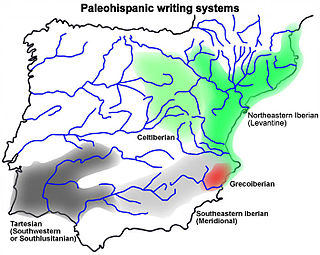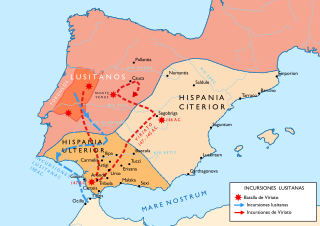
Conistorgis was the main city of the Conii or Cynetes. In the Conii language it probably meant "city of the Conii". The Celtici seem to have been present there.

Conistorgis was the main city of the Conii or Cynetes. In the Conii language it probably meant "city of the Conii". The Celtici seem to have been present there.
Conistorgis was located somewhere in the interior of the Algarve, in southernmost Portugal, although the exact location is unknown.
Strabo places the land of the Conii between the river Anas and Hieron Akroterion (sacred promontory), with the latter being the most extreme point of the known world. He places Conistorgis in Celtic territory. In 1990, the most likely location was considered to be Baixo Alentejo or Algarve, northeast of Serra do Caldeirão. [1]
Some attempts have been made to identify Conistorgis with later, Roman sites. One suggestion is that Conistorgis would have been located in Beja, one of the few Portuguese cities not to have a preroman name. This hypothesis would interpret the name Conistorgis as having a Celtic origin and meaning waterless (orgis) hill (conis) and that Julius Caesar would later rename Pax Julia. [2] Another hypothesis is that Conistorgis would correspond to Medellín, Spain. [3] None of these two suggestions are consensual among experts. [2] [3]
The Conii had made an alliance with the Romans during the conquest of the Iberian Peninsula.
Appian mentions the city twice: once, between 155 and 152 BC, when the city is raided by the Lusitanians, led by Caucenus, during the Lusitanian War against Rome. The second time is when Servius Sulpicius Galba retreats into the city around 150 BC, after his first battle against the Lusitanians. [4] Thus, the city was reconquered between 155 BC and 150 BC, probably by Marcus Atilius, when he fights against the Lusitanians and Vettones. [1]
During the Sertorian War, Conistorgis is again attacked. The Sertorian forces attack the Roman forces garrisoned in Conistorgis. [1]

Lusitania was an ancient Iberian Roman province comprising part of modern Portugal and a large portion of western Spain. It was named after the Lusitanians, an Indo-European tribe that lived in the region prior to the arrival of the Romans.

Viriathus was the most important leader of the Lusitanian people that resisted Roman expansion into the regions of western Hispania or western Iberia, where the Roman province of Lusitania would be finally established after the conquest.

The Celtiberians were a group of Celts and Celticized peoples inhabiting an area in the central-northeastern Iberian Peninsula during the final centuries BCE. They were explicitly mentioned as being Celts by several classic authors. These tribes spoke the Celtiberian language and wrote it by adapting the Iberian alphabet, in the form of the Celtiberian script. The numerous inscriptions that have been discovered, some of them extensive, have allowed scholars to classify the Celtiberian language as a Celtic language, one of the Hispano-Celtic languages that were spoken in pre-Roman and early Roman Iberia. Archaeologically, many elements link Celtiberians with Celts in Central Europe, but also show large differences with both the Hallstatt culture and La Tène culture.
The Lusitanians were a people living in the far west of the Iberian Peninsula, corresponding roughly to Central Portugal and some areas of modern-day Extremadura and Castilla y Leon, in Spain. After its conquest by the Roman Republic the land was subsequently incorporated as a Roman province named after them (Lusitania).

Faro District is the southernmost district of Portugal. The area is the same as that of the Algarve region. The administrative centre, or district capital, is the city of Faro.

The Vettones were an Iron Age pre-Roman people of the Iberian Peninsula of possibly Celtic ethnicity.

The Cynetes or Conii were one of the pre-Roman peoples of the Iberian Peninsula, living in today's Algarve and Lower Alentejo regions of southern Portugal, and the southern part of Badajoz and the northwestern portions of Córdoba and Ciudad Real provinces in Spain before the 6th century BCE. According to Justin's epitome, the mythical Gargoris and Habis were their founding kings.

The Celtici were a Celtic tribe or group of tribes of the Iberian peninsula, inhabiting three definite areas: in what today are the regions of Alentejo and the Algarve in Portugal; in the Province of Badajoz and north of Province of Huelva in Spain, in the ancient Baeturia; and along the coastal areas of Galicia. Classical authors give various accounts of the Celtici's relationships with the Gallaeci, Celtiberians and Turdetani.

The Cantabri or Ancient Cantabrians, were a pre-Roman people and large tribal federation that lived in the northern coastal region of ancient Iberia in the second half of the first millennium BC. These peoples and their territories were incorporated into the Roman Province of Hispania Tarraconensis in 19 BC, following the Cantabrian Wars.

This is a historical timeline of Portugal.

The Vaccaei or Vaccei were a pre-Roman Celtic people of Spain, who inhabited the sedimentary plains of the central Duero valley, in the Meseta Central of northern Hispania. Their capital was Intercatia in Paredes de Nava.

The Gallaeci were a Celtic tribal complex who inhabited Gallaecia, the north-western corner of Iberia, a region roughly corresponding to what is now the Norte Region in northern Portugal, and the Spanish regions of Galicia, western Asturias and western León before and during the Roman period. They spoke a Q-Celtic language related to Northeastern Hispano-Celtic, called Gallaecian or Northwestern Hispano-Celtic. The region was annexed by the Romans in the time of Caesar Augustus during the Cantabrian Wars, a war which initiated the assimilation of the Gallaeci into Latin culture.

The Southwest Script or Southwestern Script, also known as Tartessian, South Lusitanian and Conii script is a Paleohispanic script used to write an unknown language usually identified as Tartessian. Southwest inscriptions have been found mainly in the southwestern quadrant of the Iberian Peninsula, mostly in the south of Portugal, but also in Spain.

The Lusitanian War, called Pyrinos Polemos in Greek, was a war of resistance fought by the Lusitanian tribes of Hispania Ulterior against the advancing legions of the Roman Republic from 155 to 139 BC. The Lusitanians revolted in 155 BC, and again in 146 BC and were pacified. In 154 BC, a long war in Hispania Citerior, known as the Numantine War, was begun by the Celtiberians. It lasted until 133 and is an important event in the integration of what would become Portugal into the Roman and Latin-speaking world.

The Bardili were a small, pre-Roman tribe of the Iberian Peninsula, and an offshoot of the widespread Turduli people, who lived in what is now southwestern Portugal in the 5th-1st centuries BC.
This section of the timeline of Iberian history concerns events from before the Carthaginian conquests.

Lacobriga was an ancient town of Celtic origin, usually identified as the predecessor of the current city of Lagos in Portugal. The nearby Archaeological Site of Monte Molião is also known as Lacobriga.

This article covers the history of ancient Portugal, the period between Prehistoric Iberia and County of Portugal.